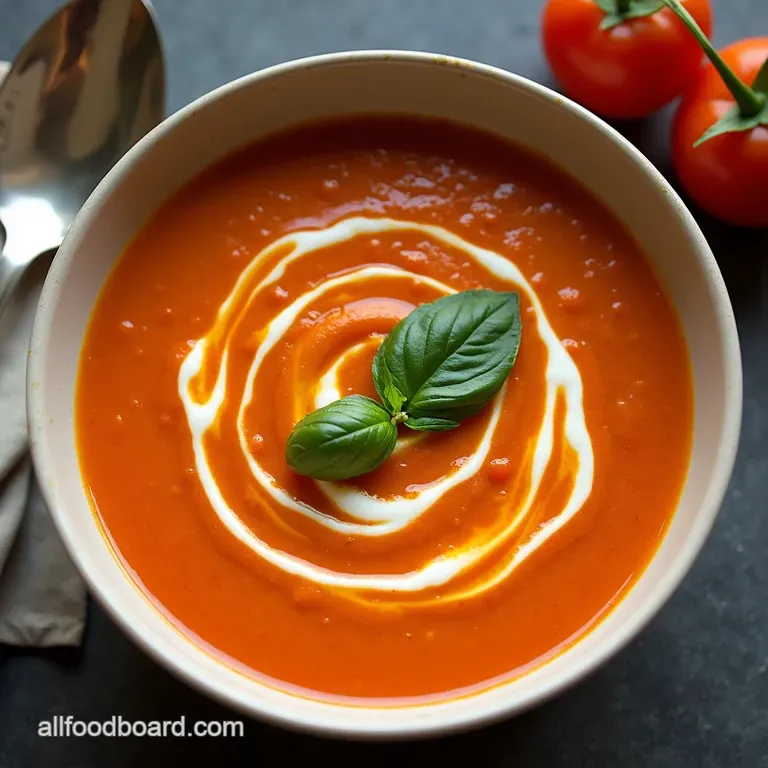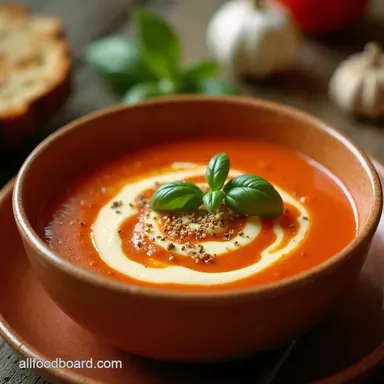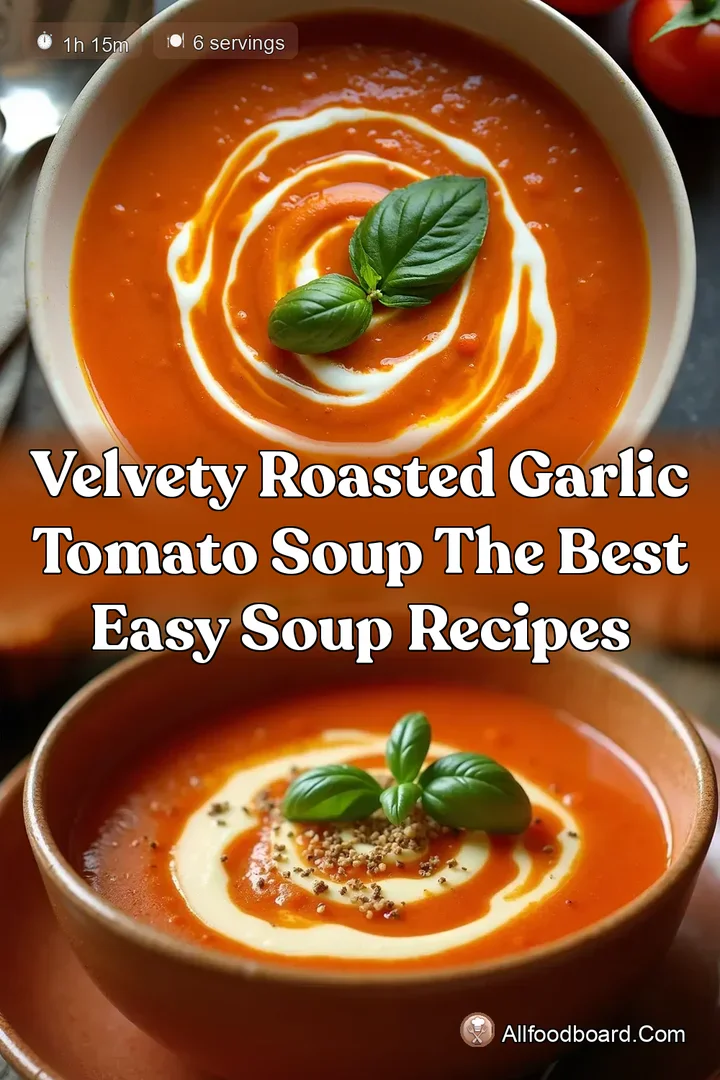The Velvety Dream Ultimate Roasted Garlic Tomato Soup with Basil Swirl

- Unveiling the Gold Standard: Why This Tomato Soup Rises Above Other Soup Recipes
- The Secret Weapon: Introducing the Roasted Garlic Element
- Curating Your Pantry for Peak Tomato Soup Flavor
- Essential Hardware: Tools for Seamless Preparation
- Phase One: Unlocking Deep Flavor Through Roasting
- The Simmering Symphony: Bringing the Ingredients Together
- Achieving Perfection: The Final Blending and Seasoning Stage
- Elevating Your Bowl: Creative Topping Pairings for Your Soup Recipes
- Flavor Evolution: Adapting This Classic Tomato Soup Base
- Recipe FAQs
Roasted Tomato Soup Recipe

Ingredients:
Instructions:
Nutrition Facts
Unveiling the Gold Standard: Why This Tomato Soup Rises Above Other Soup Recipes
When we talk about the foundational classics of comfort food, few dishes carry the emotional weight of a perfect bowl of tomato soup. Forget those tinny, overly sweet concoctions you might remember from childhood; we are aiming for something far grander. The Velvety Dream: Ultimate Roasted Garlic & Tomato Soup with Basil Swirl is not just another entry in the vast category of soup recipes ; it’s a benchmark. It transforms simple, sun-ripened fruit into a luxurious experience. Whether you are seeking quick healthy soups for a light lunch or a deeply satisfying base for healthy soup recipes for dinner , this recipe delivers unparalleled depth using foundational cooking techniques that are surprisingly straightforward. This approach ensures that even those new to cooking can master easy soup recipes that taste world-class.
The Secret Weapon: Introducing the Roasted Garlic Element
What elevates this particular recipe above standard fare is the intentional layering of flavour, beginning long before the pot ever hits the stove. The inclusion of slow-roasted garlic is the transformative step. Roasting takes the harsh, pungent edge off raw garlic and converts its sugars into a sweet, mellow, nutty paste that melts invisibly into the broth, providing an umami backbone that mimics slow reduction.
Setting the Stage: A Comfort Food Masterpiece
This soup achieves that rare status of being both sophisticated and utterly comforting. It’s sunshine captured in a bowl, proving that even humble ingredients, when treated with respect, can yield magic. While many Chicken Soup Recipes or hearty stews dominate cold-weather menus, this creamy tomato preparation offers brightness and warmth, making it suitable for almost any season. It’s the ideal candidate to anchor any collection of versatile soup recipes for lunch .
Why Creamy Texture is Non-Negotiable for the Perfect Bowl
Texture, in the world of velvety puréed soups, is everything. We aim for a mouthfeel that coats the tongue—smooth, rich, and utterly seamless. This dedication to texture is what separates a truly memorable bowl from an adequate one. Achieving this requires attention to the blending stage, ensuring every fibrous element is fully integrated. This dedication to mouthfeel is what moves this recipe firmly into the realm of premium soup recipes .
Beyond Basic: Flavor Depth in Under 60 Minutes
Despite the depth of flavour achieved, this recipe manages to be remarkably efficient. While the actual cooking time clocks in slightly over an hour (including roasting), the active preparation time is minimal—just about 20 minutes to prep the vegetables. This efficiency makes it a wonderful option when you need easy healthy soups that don't taste rushed. It’s a compelling counterpoint to many time-consuming Slow Cooker Soup Recipes , delivering intense flavour without the all-day wait.
Curating Your Pantry for Peak Tomato Soup Flavor
To ensure your final product sings, the quality of your starting ingredients is paramount. Since the core flavour comes primarily from tomatoes and aromatics, there is nowhere to hide substandard produce. We are building a flavour foundation, and every component must be top-tier.
Essential Hardware: Tools for Seamless Preparation
While you don't need a professional kitchen setup, a few specific tools will significantly ease the process and guarantee the desired smooth texture. Forget flimsy stockpots; you need substantial equipment to handle the heat required for proper caramelization.
Selecting the Premier Produce: Tomatoes and Aromatics Deep Dive
The backbone of this recipe relies on about 3 lbs (1.4 kg) of ripe Roma or vine tomatoes, halved lengthwise to expose their juicy insides to the heat. Alongside the tomatoes go two whole heads of garlic, crucial for that signature sweetness. We trim the very top quarter-inch off the heads to expose the cloves, allowing the olive oil to penetrate during roasting. An essential element for depth is the tomato paste; we will be 'blooming' this later to deepen its flavour profile beyond just the fresh tomatoes.
The Dairy Dilemma: Choosing Your Creamy Enhancer
For true, luxurious richness, 1/2 cup of heavy cream is specified. This lends a beautiful silken finish. However, for those seeking lighter alternatives, whole milk can be substituted, though the texture will be slightly less substantial. If you are exploring Vegetarian Soup Recipes that lean towards plant-based, we will cover dairy-free alternatives later, but for this primary recipe, the cream provides that classic, satisfying coating mouthfeel.
Stock vs. Water: The Liquid Foundation Decision
We opt for 4 cups of low-sodium vegetable or chicken broth. Using broth over plain water is non-negotiable; it introduces background flavour notes—savory depth that water simply cannot replicate. Using low-sodium broth ensures that when we season later, we retain ultimate control over the final salinity.
Measuring Precision: Don't Skip the Spice Ratios
While seasoning is often done 'to taste,' the initial measurement of dried oregano (1 teaspoon) is vital for the roasting stage, as it infuses the tomatoes with an earthy Mediterranean note. A small, optional pinch of sugar (1/2 teaspoon) is reserved only to balance potential harsh acidity from the tomatoes after blending, so keep it handy but use it sparingly.
Related Recipes Worth Trying
- Light Airy Cottage Cheese Mousse Recipes No Bake — Discover the best cottage cheese mousse recipes This simple lemonberry swirl is highprotein unbelievably light and perfect for healthy dessert cravings
- The Ultimate SetandForget Crockpot Chicken and Rice Soup — Our foolproof Crockpot Chicken and Rice Soup recipe delivers deep comforting flavour with minimal effort This healthy slow cooker option is perfect for easy...
- Easiest Creamy Crockpot Ham and Potato Soup Recipe — A hug in a bowl This simple Crockpot Ham and Potato Soup recipe uses leftovers beautifully for a satisfying meal Taste the comfort
Phase One: Unlocking Deep Flavor Through Roasting

This initial step is where the magic begins. On a large, rimmed baking sheet, toss the halved tomatoes, quartered onion, and the trimmed garlic heads with olive oil (about 2 Tbsp), dried oregano, salt, and pepper. The objective here is not just to soften them, but to encourage genuine caramelization. Roast at 400° F ( 200° C) for 30 to 35 minutes. You are looking for tomatoes that have slightly collapsed and onions that have started to brown at the edges.
The Simmering Symphony: Bringing the Ingredients Together
While the vegetables are roasting, we prepare the aromatic base in a heavy-bottomed Dutch oven. Melt 2 tablespoons of unsalted butter with the final tablespoon of olive oil over medium heat. Crucially, we add the 2 tablespoons of tomato paste and sauté it for a full two minutes, stirring constantly until it darkens slightly. This process, known as ‘blooming’ the paste, concentrates its flavour significantly. Once the vegetables are done roasting, squeeze the now-soft, roasted garlic pulp directly from its skins into the pot. Add all the roasted tomatoes, onions, and any accumulated pan juices, followed by the 4 cups of broth. Bring the mixture to a gentle simmer, cover, and let it meld for 15 minutes. This gentle simmer allows the intense roasted notes to fully integrate into the broth.
Achieving Perfection: The Final Blending and Seasoning Stage
This stage transforms our chunky pot into the velvety dream promised in the title.
Prepping the Garlic: Caramelization Techniques
The pre-roasting step ensured the garlic has shed its aggressive nature, becoming sweet and spreadable. Squeezing this pulp out, rather than trying to chop it, ensures it dissolves seamlessly into the liquid during the blending process, providing maximum impact without any abrasive texture.
The Art of the Sauté: Building the Aromatic Base
The brief, careful sauté of the tomato paste is an underappreciated skill, especially in Easy Healthy Soups . Cooking the paste before liquid is added cooks off the raw metallic edge, significantly enriching the final colour and flavour profile of the entire dish, much like developing flavour in Soup Recipes for Fall chilli bases.
Slow Cooking Secrets: Developing the Broth Intensity
Although this isn't strictly a long slow-cooker affair, the 15-minute covered simmer after combining all roasted elements is essential. It’s not about cooking the vegetables further, but about allowing the liquid to absorb the full spectrum of flavour created by the roasting process, ensuring the broth has maximum intensity before the blending begins.
Tool Talk: Mastering the Immersion Blender vs. Countertop Unit
For achieving that true velvet texture, an immersion blender (stick blender) used directly in the pot is the easiest, safest route. If you must use a standard countertop blender, you must work in batches, filling the carafe no more than halfway. Hot liquids expand rapidly; always remove the centre cap from the lid and cover the opening with a folded kitchen towel to allow steam to escape safely while blending.
Elevating Your Bowl: Creative Topping Pairings for Your Soup Recipes
A smooth soup cries out for textural contrast. The final touches are where you can personalize your creation, transforming it from a great soup into an unforgettable meal. This is especially useful when planning a variety of soup recipes for lunch throughout the week.
Garnishes That Go the Extra Mile: Croutons, Herbs, and Cheese
The essential finishing touch involves a light drizzle of high-quality extra virgin olive oil—its fruity flavour cuts through the richness—and a scattering of basil chiffonade (thinly sliced leaves). For crunch, homemade sourdough croutons tossed with a touch of garlic powder add substance. A sprinkle of grated Parmesan or sharp white cheddar is also welcome, though optional.
Making Ahead: Smart Storage and Reheating Protocols
This soup stores beautifully. Once completely cooled, transfer it to airtight containers. It keeps well in the refrigerator for up to four days. When reheating, bring it slowly up to temperature on the stovetop, stirring frequently. Avoid aggressively boiling, especially if you added cream, to maintain that perfect velvety consistency.
Vegan & Dairy-Free Substitutions for a Plant-Forward Experience
This recipe adapts beautifully to plant-based diets. When creating Vegetarian Soup Recipes , simply omit the heavy cream. To replace the fat and texture, blend in 1/2 cup of raw cashews (soaked in hot water for 30 minutes prior to blending) along with the soup, or use an equal amount of full-fat canned coconut milk, stirring it in during the final heating stage.
Nutritional Snapshot: Understanding the Benefits of This Wholesome Meal
Beyond the taste, this dish offers significant nutritional value. Tomatoes are rich in lycopene, and the high vegetable content ensures an excellent fibre profile (around 7g per serving). Even with the cream, if kept moderate, this remains a lighter option compared to heavy cream-based soups, making it an excellent staple when looking for satisfying Easy Healthy Soups .
Flavor Evolution: Adapting This Classic Tomato Soup Base
The beauty of a perfectly executed base recipe like this is its adaptability. Once you master the roasting and blending technique, you have a blank canvas for countless variations.
Freezing for Future Feasts: Best Practices for Longevity
For long-term storage, this soup freezes exceptionally well for up to three months. Always cool the soup completely before transferring it to freezer-safe bags or containers, leaving an inch of headspace for expansion. Thaw overnight in the refrigerator before reheating gently on the stovetop.
Flavor Evolution: Adapting This Classic Tomato Soup Base
If you want to explore other Soup Recipes based on this texture, consider adding ingredients during the simmering stage (Step 3). For instance, you can introduce 1/2 cup of red lentils with the broth for a significant protein boost, creating a heartier meal that still blends smoothly. Alternatively, adding a whisper of smoked paprika during the sautéing stage provides a lovely smoky note reminiscent of certain hearty Soup Recipes for Fall dishes.

Recipe FAQs
I’m a beginner; is making a truly flavourful soup like these Soup Recipes too difficult?
Not a chance! While some elaborate soups take time, the core technique here—roasting the veggies—is really straightforward. It just means tossing ingredients on a tray and forgetting them for a bit. It’s an excellent way to build deep flavour without spending hours hovering over a hob.
My tomatoes weren't very sweet. How can I fix a soup that tastes too acidic or bland?
This is where proper seasoning, or "tasting like a chef," comes in! If it’s too sharp, stir in a tiny pinch of sugar or a splash of carrot juice to balance the acidity, just as we suggest. If it tastes flat, a splash of high-quality sherry vinegar or balsamic vinegar right at the end can wake up all those sleepy flavours—don't be shy with the salt, either!
I made a huge batch! How long will this tomato soup keep in the fridge, and can I freeze it?
This soup is even better the next day, honestly! It keeps beautifully in an airtight container in the fridge for up to five days. Yes, it freezes brilliantly too; cool it down completely first, then store it in freezer-safe containers, leaving an inch or so of headspace for expansion. It should last a good three months frozen solid.
I want to make this recipe vegan. Can I swap out the cream and butter without losing the velvety texture?
Absolutely, you can achieve that luxurious texture dairy-free! Ditch the butter and use olive oil throughout. For the cream, blending in 1/2 cup of soaked raw cashews or using full-fat coconut milk (the thick part from the can) works wonders for that rich mouthfeel. Just make sure to blend it thoroughly until silky smooth.
What’s the best way to add more protein to these kinds of Soup Recipes for a proper main course?
To bulk up your bowl, you have a few top-tier options. Stirring in a cup of cooked white beans or lentils during the final simmer works wonders for fibre and protein. Alternatively, you can serve a dollop of plain Greek yogurt (if not vegan) or sprinkle some toasted pumpkin seeds (pepitas) over the top just before serving for added texture and nutrients.
Why do your instructions stress roasting the vegetables for these types of Soup Recipes?
Roasting is our secret weapon—it caramelizes the natural sugars in the tomatoes and garlic, taking them from simple vegetables to deep, complex flavour bombs. Boiling them just gives you watery flavour; roasting concentrates the essence, which is why this soup tastes like it simmered for hours, even when it hasn't!